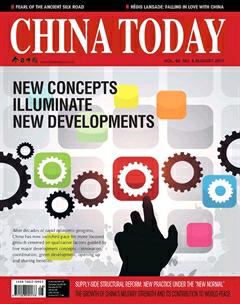Society
China Contributes to Slower Energy Demand and Consumption
China played a critical role in the slower growth of global energy demand and consumption as well as the nearly flat growth of carbon emissions in 2016, according to the latest BP world energy report.
Global energy consumption grew slowly again in 2016 – the third consecutive year in which demand has grown by one percent or less – much weaker than the rates of growth over the previous 10 years or so, according to the report, 2017 BP Statistical Review of World Energy.
“From a global level, much of this improvement can be traced back to the pronounced changes in the pace and pattern of economic growth and energy consumption within China,” BP Group CEO Bob Budley said in the report. Energy consumption in China grew by just 1.3 percent in 2016. Its growth during 2015 and 2016 was the lowest over a two-year period since 1997-98, according to the report. China, however, remained the worlds largest growth market for energy for a 16th consecutive year.
China was the key driver of the growth of global renewable energy last year, accounting for more than 40 percent of the growth in renewable power, more than that of the entire Organization for Economic Cooperation and Development. China also overtook the U.S. as the largest producer of renewable power.
Some structural changes happening in China include slower economic growth, a change in the structure of economic growth away from energy-intensive industrial sectors toward the consumer and service sectors, and a shift in the fuel mix away from coal toward more renewable energy, nuclear power and natural gas.
Huge Dragonfly Fossil Found
Chinese researchers have been studying a 200-million-year-old dragonfly fossil.
Scientists with Nanjing Institute of Geology and Paleontology under the Chinese Academy of Sciences said that the dragonfly, which lived in the late Triassic period, was discovered in the Junggar Basin in Xinjiang Uygur Autonomous Region in 2013.
A single wing of the animal is about 101 mm long, the second largest dragonfly fossil ever found in China. The largest had a wing length of 107.6 mm. Modern dragonflies have a wingspan ranging from 30 to 90 mm. The largest dragonfly fossil ever discovered had a wingspan of 710 mm and lived in the early Permian period some 280 million years ago.
Dragonflies have become increasingly smaller since they came into being around 300 million years ago. With the lowering of oxygen levels in the air and the appearance of predators, large dragonflies with poor maneuverability gradually went extinct.
Better and More Accessible Medicare
The 2016 Green Book of Health Reform and Development shows that more than 1.3 billion Chinese, or 96.5 percent of the population, carried basic medical insurance by the end of 2015. Both Chinas medicare coverage and level of benefit have been growing. About 50 percent of a carriers medical payments could be reimbursed. The carriers share in medical payment in 2015 fell by 1.43 percent from 2014, and by 30 percent from 2001. For those who chose the serious illness insurance for rural and non-working urban residents, approximately 90 percent bear no more than RMB 15,000 themselves.
Road Access Rises
Chinas road transport system has been remarkably improved over recent years, with the mileage of expressways being the worlds largest and rural roads reaching 3.96 million km.
By the end of last year 131,000 km expressways were in operation across the nation, growing by 35,000 km and at a year-on-year rate of eight percent. The expressway network now covers all cities and towns with a population of 200,000 or more. And the number of provinces with more than 5,000 km expressways in operation has increased from four to 12.
The progress in central and western China has outpaced the national average. The mileage of expressways open to traffic in 20 central and western provinces stood at 89,000 km at the end of last year, growing by 28,000 km, or 45 percent from the end of 2012.
From 2013 to 2016, China built 980,000 km of rural roads, which gave 406 more towns and 59,600 more villages access to paved roads. So far, 99 percent of Chinese towns and 96.7 percent of villages are connected with paved roads, which has laid a solid foundation for the countrys battle against poverty in rural areas.
Activity
Papirus
Date: August 23-28, 2017
Place: National Center for the Performing Arts
Price: RMB 160/220/280
Papirus makes us ponder over how to react to a stranger. Using only gestures and paintings, two actors establish a game full of curiosity, generosity and hope whereby sharing becomes a form of communication. The performance reveals the magic that unfolds when we allow ourselves to open our hearts.
Fourth Shanghai Popular Science Products Expo
Date: August 25-28, 2017
Place: Shanghai Exhibition Center
Price: RMB 45/85/115
Science and technology museums and parks from China and scientific companies from over 12 countries and regions including the U.S., Germany, Japan, and Malaysia are to participate in the expo, offering a great opportunity for both adults and children to encounter advanced technologies and learn to use scientific knowledge to better identify authentic information.

